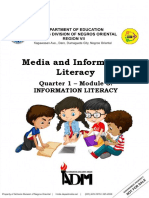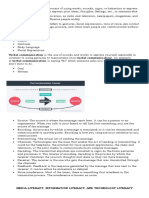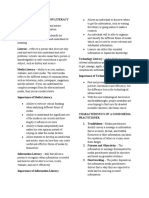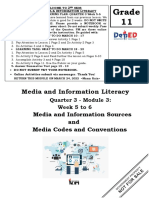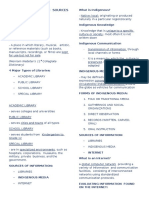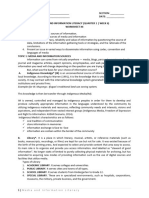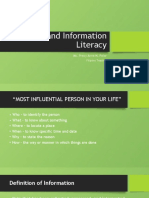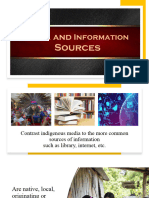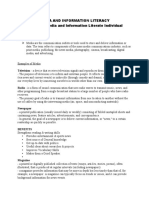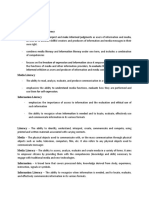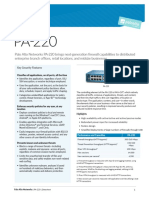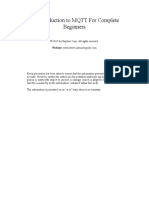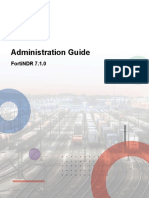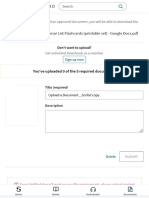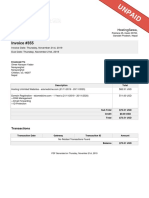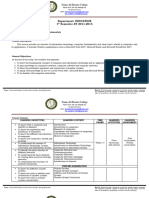MEDIA AND INFORMATION LITERACY
MODULE 2
INFORMATION LITERCY
Literacy and Empowerment
Literacy is widely known as the ability to read and write. The advent of modernity and the expansion of access to general education
has enabled societies to produce literate populations. Literacy always associated with a set of tangible skills, particularly the skills of
writing and reading. Its counterpart is the concept of numeracy, which is the skills associated with basic mathematical operations
involving numbers.
The United Nations Educational, Scientific, and Cultural Organization (UNESCO) cites the importance of literacy in the modern world:
“Literacy is a fundamental human right and the foundation for lifelong learning. It is fully essential to social and human development
in its ability to transform lives. For individuals, families, and societies alike, it is an instrument of empowerment to improve one’s
health, one’s income, and one’s relationship with the world.” (UNESCO, 2003)
Empowerment is very significant in our appreciation of how literacy provides us with means to access the world of knowledge so
we can lead better lives. Empowerment is an idea of power, as linked on the idea that power can change, that the ownership of
power can shift form one entity to another. Empowerment is also possible because power can expand or diminish as the case may
be. “Let us first review our notions of power.
Power is often related to our ability to make others do what we want, regardless of their own wishes or interests (Weber, 1946).
Power is not always relational. One needs to cultivate a notion of power within to fully realize. True enough, power can reside inside,
you given the opportunity to access the knowledge, skills, and attitudes.
Information and Internet
Information can be the answer to a question, a news, or a data. It is that which informs, that which enables us to know and something
also communicable.
Information literacy is best understood on how we navigate the complex and networked world of the internet. The internet has more
than practical uses in our lives. It has been transformed to be the primary source for research, complementing what can be found in
school libraries.
Today, we live in a knowledge-based society surrounded by cutting-edge technology that makes every aspect of our lives faster and
easier. The internet arose in 1968, but it was in 1989 when a fully developed World Wide Web (WWW) arose and turned it into the
global platform for knowledge-sharing, communication, and achieving.
The Internet is an increasingly important part of everyday life for people around the world. But if you've never used the Internet
before, all of this new information might feel a bit confusing at first. The Internet is a global network of billions of computers and
other electronic devices. With the Internet, it's possible to access almost any information, communicate with anyone else in the world,
and do much more.
You can do all of this by connecting a computer to the Internet, which is also called going online. When someone says a
computer is online, it's just another way of saying it's connected to the Internet.
The World Wide Web—usually called the Web for short—is a collection of different websites you can access through the Internet.
A website is made up of related text, images, and other resources. Websites can resemble other forms of media—like newspaper
articles or television programs—or they can be interactive in a way that's unique to computers.
The purpose of a website can be almost anything: a news platform, an advertisement, an online library, a forum for sharing images,
or an educational site.
Who Puts Information on the Internet?
There are many kinds of Internet sites that you might find during the course of a search – sites created by different people or
organizations with different objectives. The three-letter code preceded by a dot (.), simply known as the domain, gives you a fairly
good idea of who is publishing the internet site.
� Domain Equivalent
Names
.edu Educational institution
It may contain carefully processed and reviewed information tough not represent the individual views of the
academic personnel.
.com Mostly commercial entities, some of which are profit-oriented.
.org Non-profit organization
.gov Government organizations
.net Internet services providers or network
What Determines Your Need for Information?
Information seeking is relatively synonymous to the idea of research. When you locate information. You employ the necessary skills
to engage in the research process. Your need for information depends on your prior knowledge and experience, as well as your
goals and objectives.
Your information needs to rely on what questions or problems you would like to solve or, simply, what you need the information for.
These needs also depend on the relevance of the information you seek to the task you are supposed to accomplished. Ask yourself
who will consume and/ or benefit from the information you are trying to locate. You must also identify how much information you
need and its adequacy to address your task. Consult your personal knowledge base so that you can plan what else to search to
augment what you already know.
Sources of Information
Sources of information, drawn from the internet or otherwise, can be categorized into the following:
1. Popular Publications: Most of what rules in the print and non-print media are popular publications with the general public as its
target audience. Included under this category are journalistic articles, features articles, manuals, flyers, fact sheets, and even blogs
by netizens. They serve to both inform and entertain the general public.
2. Scholarly Publications: These are well-researched articles found mostly in academic journals and published for the specialists of
a specific field. The language is very technical because it is geared toward the consumption of specialists, scholars, and those
seeking research-based information on a particular area of knowledge such the social science, the natural sciences, and the arts
and humanities.
3. Trade Publication: These are also highly specialized materials meant for the players and specialists of a specific industry. Some
good examples are publications on motoring or publications on construction. Trade Publications combine popular appeal and
specialized knowledge because it also needs to attract the non-specialist who are the potential consumers of users of a particular
product.
Format of Information
FORMAT DESCRITION
Materials produced and collected from print resources (books, newspapers, and other periodicals,
Print manuscripts, correspondence, memoranda, loose leaf materials, notes, brochures, etc.).
Digital materials are information materials that are stored in an electronic format on a hard drive, CD-ROM,
Digital Formats remote server, or even the Cloud. These could be electronic books, database websites, video, and audio
materials. These materials may be accessed with a computer and/or through the internet.
Audio and Video Materials collected using analog technology in video (television, video, recordings) tools presented in
Format recorded tapes, CDs, audiocassettes, reel to reel tapes, record albums, etc. As differentiated from digital
technology, these sources of information are recorded using analog technology which means data is
recorded in advance from one point to another. Analog devices read the material by scanning the physical
data off the media.
This includes materials that have been photographed and their images developed in reduced-size film
Microform strips and which are viewed using machines with magnifying lenses.
There is a need to do an analysis of what type of information will best serve your need, what access tools are you going to utilize,
and what results will be critical to the success of your information retrieval.





